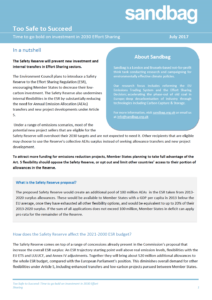This briefing explores the impact of the proposed ‘Safety Reserve’ on the 2030 Effort Sharing Regulation (ESR) and the the ability of Member States to trade Annual Emissions Allowances (AEAs) under Article 5 with use of various emissions scenarios. In particular it addresses the following issues:
- How the Safety Reserve affects the 2021-2030 ESR budget,
- What Member State allowance balances are expected to look like in 2030 and which Member States will have an AEA deficit,
- Which Member States are most likely to have access to the Safety Reserve and how allowances will be distributed once the 2030 balances, and other eligibility criteria for the Reserve, are taken into account.
We find that most potential new AEA sellers that are eligible for the Safety Reserve will overshoot against their 2030 targets and are not expected to need the mechanism. Other recipients that are eligible may choose to use the Reserve’s collective AEAs surplus instead of seeking allowance transfers and new project development.
To attract more funding for emissions reduction projects, Member States planning to take full advantage of the Art. 5 flexibility should oppose the Safety Reserve, or opt out and limit other countries’ access to their portion of allowances in the Reserve.
*19th JULY UPDATE*
Values shown in Table 2 have now been corrected.
Project tile construction image by aamiraimer

